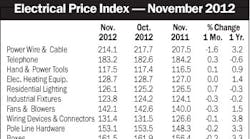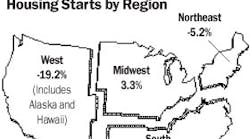Latest from Mag
People - Dec 21, 2012
Obituaries - Dec 21, 2012
November EPI Index Shows No Change
Housing Starts Dip 4% in November
Electrical Marketing - December 21, 2012
Around the Industry - Dec 21, 2012
Business confidence in current conditions affecting the electrical manufacturing industry remained constant or edged slightly higher in July compared to June in all regions of the world except Asia/Pacific, according to NEMA’s Electroindustry Business Confidence Index (EBCI). In the Asia/Pacific region, the confidence index rebounded dramatically from a SARS-related plunge that began in February 2003.
Based on the results of a monthly survey of senior managers at member companies of the National Electrical Manufacturers Association (NEMA), Washington, D.C., the current conditions index for North America and Asia Pacific was above the threshold level of 50, but remained below 50 in Latin America and Europe. An index reading above 50 indicates expansion; below 50 indicates that the manufacturing economy is generally contracting.
In contrast, confidence in conditions six months from now was above 50 in July for all regions, with confidence widening from June for all regions except Latin America. Most comments by respondents focused on a slight improvement in business conditions, but lack of confidence in whether the improvement would be sustained.
Said one respondent, “Some improvement this month although it continues to be spotty. It is not clear whether this improvement will be sustained. In any case, the improvement is marginal and does not imply a dramatic recovery.”
North America In July, the current conditions index was nearly unchanged from June, rising just over a point to 58. The index has hovered in a narrow band between 56 and 58 since May 2003. The fact that the index has failed to push further above 50 no doubt reflects the unevenness of the current economic recovery. The recent modest increases in industrial manufacturing production support the improving view of current conditions affecting the electroindustry. Manufacturing industrial production increased 0.4 percent in June 2003 following a 0.1 percent increase in May, the first back-to-back increase since August 2002. However, compared to June 2002, production was down 1.0 percent. Manufacturing capacity utilization also edged up to 72.8 percent in June 2003 from 72.6 percent in May 2003, and it was 0.7 percent higher than in June 2002.
Looking forward, confidence in future conditions grew to its widest level in July since April 2002. The index increased to 86 from 81 in June and was the highest of all regions once again for the eighth consecutive month. The expanding confidence in future conditions is to be expected given that most economists are predicting stronger growth in the second half of 2003 for the United States. Many analysts expect that the combined effect of a significant tax cut, lower interest rates, weakening dollar, lean inventories, improving consumer confidence and reduced uncertainty about U.S. military plans will finally jumpstart the economy sometime in the next six months.
Latin America Confidence in current conditions south of the U.S. border remained unchanged in July, matching the June reading of 45. Although the index remains below 50, it is at its highest level since the index was initiated in March 2001. The growing confidence is understandable given some of the improving data from the region.
Survey participants apparently have doubts about the strength of the recovery, as the July index of confidence six months from now narrowed to 60 from 68 in June. Nevertheless, the index has remained at or above 50 since October 2001.
Europe Not surprisingly, given the abundant negative economic news from this region, the current conditions index for Europe indicates the lowest degree of confidence of all the regions, with a reading of 30 in July compared to 24 in June. The major European economies are unable to combat stagnant growth with the usual monetary and fiscal policy stimulus because of the unified currency and EU controls on debt levels. Stagnant growth in Germany in April produced the largest monthly number of corporate bankruptcies since World War II. Meanwhile, the next largest economy in the region, France announced that for the third year in a row its budget deficit would exceed the 3 percent of GDP limit established by the EU. As a whole, Europe’s economy is expected to grow less than 1 percent this year and less than 2 percent each year, as EU deficit regulations and monetary policy keep the powerhouse economies in a stranglehold, and the weakening dollar reduces export potential.
The relatively gloomy outlook for the region not withstanding, confidence in conditions six months from now reached 59 in July compared to 47 in June, indicating conditions in the region are expected to be conducive to economic expansion. One bright spot in the region is the telecom sector, which has recovered much more quickly than in the United States.
Asia/Pacific Confidence in current conditions in the Asia/Pacific region widened significantly in July to 62 fom 38 in June. The July index is the highest since December 2002, before the widespread fear of SARS occurred. Phenomenal economic growth in China is likely the primary reason for increased optimism in the region. Last winter, the SARS epidemic severely curtailed economic activity across the region, especially in China. But in the months since the epidemic has been contained, economic growth has exploded in China at nearly double the rate of last year.
Looking ahead, confidence in conditions six months from now also widened in July to an index value of 82 from 78 in June.

